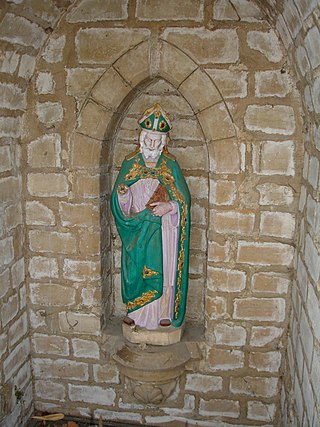Saint Genesius of Clermont | |
|---|---|
 | |
| Born | unknown |
| Died | circa 662 |
| Venerated in | Roman Catholic Church |
| Feast | June 3 |
Saint Genesius (died circa 662) is a French saint. He was the twenty-first Bishop of Clermont and his feast day is celebrated on June 3.
Saint Genesius of Clermont | |
|---|---|
 | |
| Born | unknown |
| Died | circa 662 |
| Venerated in | Roman Catholic Church |
| Feast | June 3 |
Saint Genesius (died circa 662) is a French saint. He was the twenty-first Bishop of Clermont and his feast day is celebrated on June 3.
A legend, which is of a rather late date (Acta SS., June, I, 315), says that he was descended from a senatorial family of Auvergne. [1] Having received a liberal education he renounced his worldly prospects for the service of the Church, became archdeacon of Clermont under Bishop Proculus. The parents of Saint Prix entrusted his education to Bishop Genesius. [2]
Despite his protests, Genesius succeeded Proculus in the episcopacy in 656. [3] Genesius (locally known as Saint Genes) was a prelate of austere piety and wholly devoted to his flock. [4]
He laboured earnestly for the maintenance of Christian morality, and founded a hospital at Clermont and also the Abbey of Manlieu. After serving as bishop for five years, fearing for his own soul, he left Clermont secretly and went to Rome in the garb of a pilgrim. The bereaved flock sent a deputation to the Holy See. Genesius was found and induced to return. [1]
Genesius then proceeded to build a monastery at Chantoin, [5] a church and a hospice. He was buried in the church which he had built at Clermont in honour of St. Symphorian, and which later took his own name. [1] In the life of Praejectus (Prix), Genesius is mentioned as one of the protectors of his childhood.
Genesius died about 662 in the seventh year of his Episcopate.

Gatianus in the third century AD was the founding bishop of the see of Tours. He was one of the "seven apostles of Gaul" commissioned by Pope Fabian to evangelize in the region.

Stremonius or Saint Austremonius or Saint Stramonius or Austromoine, the "apostle of Auvergne," was the first Bishop of Clermont. He is venerated as a saint in the Catholic Church.

Saint Deiniol was traditionally the first Bishop of Bangor in the Kingdom of Gwynedd, Wales. The present Bangor Cathedral, dedicated to Deiniol, is said to be on the site where his monastery stood. He is venerated in Brittany as Saint Denoual. In English and Latin his name is sometimes rendered as Daniel.

Genesius of Rome is a legendary Christian saint, once a comedian and actor who had performed in plays that mocked Christianity. According to legend, while performing in a play that made fun of baptism, he had an experience on stage that converted him. He proclaimed his new belief, and he steadfastly refused to renounce it, even when the emperor Diocletian ordered him to do so.

Genesius of Arles was a notary martyred under Maximianus in 303 or 308. He is honoured in the Catholic Church as the patron saint of notaries and secretaries, and invoked against chilblains and scurf. His feast day is celebrated on August 25.
Saint Aldric was Bishop of Le Mans in the time of Louis the Pious.
Anastasius I of Antioch was the Patriarch of Antioch twice.

Atto of Pistoia, or Saint Atto, was a Catholic bishop and a professed member from the Vallumbrosan Order as well as the Bishop of Pistoia and a noted historiographer.

Maximus of Turin was a Roman Christian prelate known as the first Bishop of Turin. He was a theological writer who "made a great contribution to the spread and consolidation of Christianity in Northern Italy".
Nicomedes was a martyr of unknown era, whose feast is observed 15 September. He was buried in a catacomb on the Via Nomentana near the gate of that name.
Andrew the Scot was the Irish-born student and assistant of Donatus of Fiesole. He served as archdeacon of Fiesole under Bishop Donatus.

Pierre Denaut was the tenth bishop of the Roman Catholic diocese of Quebec and the last before it became an Archdiocese. He served as bishop from 1797 to 1806.

Symphorian, Timotheus (Timothy), and Hippolytus of Rome are three Christian martyrs who, though they were unrelated and were killed in different places and at different times, shared a common feast day in the General Roman Calendar from at least the 1568 Tridentine calendar to the Mysterii Paschalis. While still a young man, Symphorian was either beheaded or beaten to death with clubs.

Saint Fulcran was a French saint. He was bishop of Lodève.
Barbatus of Benevento, also known as Barbas, was a bishop of Benevento from 663 to 682. He succeeded Ildebrand in this capacity. He assisted in a church council called by Pope Agatho in Rome in 680 and in 681 attended the Third Council of Constantinople against the Monothelites.

Praejectus, Prejectus or Projectus (625–676) was a bishop of Clermont, who was killed together with the abbot Amarinus as a result of contemporary political struggles.
Saint Genesius of Lyon was the 37th Archbishop of Lyon.
Genesius, Count of Clermont was a noble of Gaul and reputed miracle worker. He was said to be Count of Auvergne. His residence was at Combronde.
Asterius of Petra was a convert from Arianism, and later the Bishop of Petra.

Rusticus of Clermont was a Bishop of Clermont in Auvergne. His feast day is 24 September.